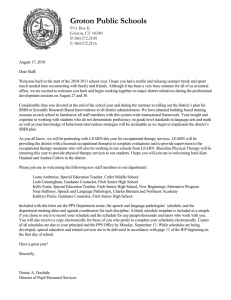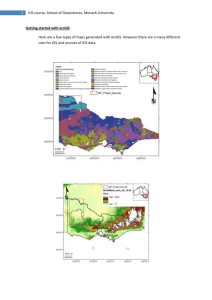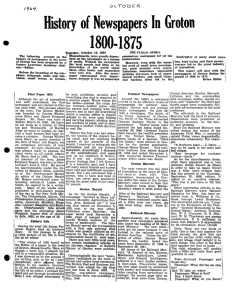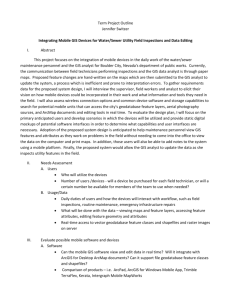Land Use: LANDUSE2005_POLY_MIDD
advertisement
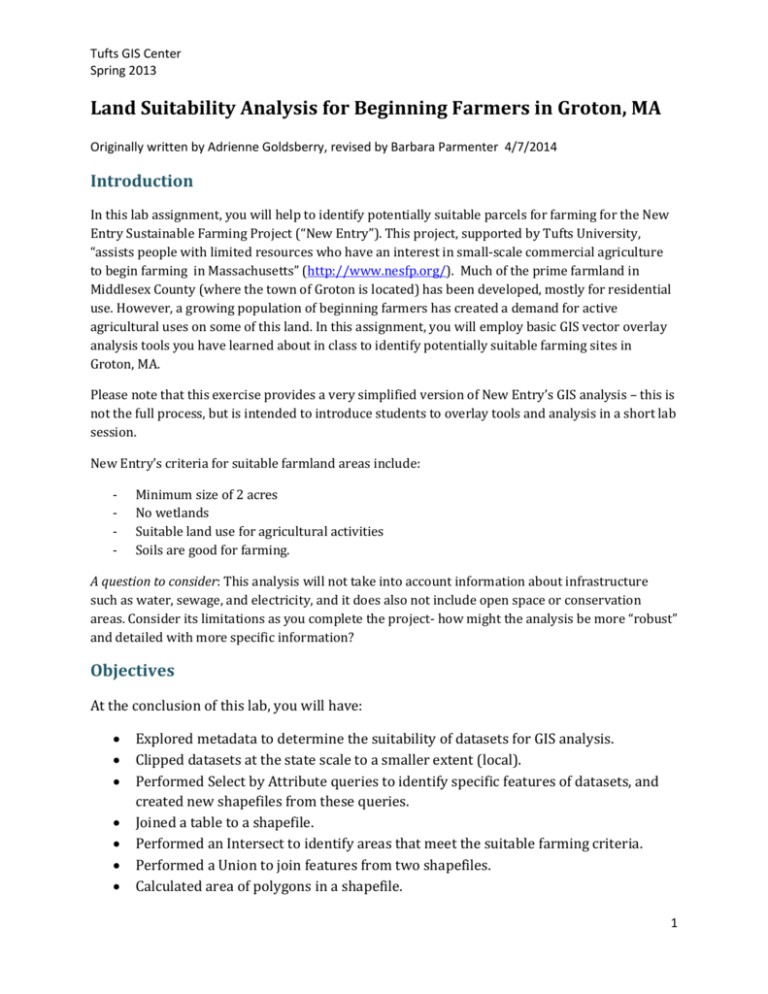
Tufts GIS Center Spring 2013 Land Suitability Analysis for Beginning Farmers in Groton, MA Originally written by Adrienne Goldsberry, revised by Barbara Parmenter 4/7/2014 Introduction In this lab assignment, you will help to identify potentially suitable parcels for farming for the New Entry Sustainable Farming Project (“New Entry”). This project, supported by Tufts University, “assists people with limited resources who have an interest in small-scale commercial agriculture to begin farming in Massachusetts” (http://www.nesfp.org/). Much of the prime farmland in Middlesex County (where the town of Groton is located) has been developed, mostly for residential use. However, a growing population of beginning farmers has created a demand for active agricultural uses on some of this land. In this assignment, you will employ basic GIS vector overlay analysis tools you have learned about in class to identify potentially suitable farming sites in Groton, MA. Please note that this exercise provides a very simplified version of New Entry’s GIS analysis – this is not the full process, but is intended to introduce students to overlay tools and analysis in a short lab session. New Entry’s criteria for suitable farmland areas include: - Minimum size of 2 acres No wetlands Suitable land use for agricultural activities Soils are good for farming. A question to consider: This analysis will not take into account information about infrastructure such as water, sewage, and electricity, and it does also not include open space or conservation areas. Consider its limitations as you complete the project- how might the analysis be more “robust” and detailed with more specific information? Objectives At the conclusion of this lab, you will have: Explored metadata to determine the suitability of datasets for GIS analysis. Clipped datasets at the state scale to a smaller extent (local). Performed Select by Attribute queries to identify specific features of datasets, and created new shapefiles from these queries. Joined a table to a shapefile. Performed an Intersect to identify areas that meet the suitable farming criteria. Performed a Union to join features from two shapefiles. Calculated area of polygons in a shapefile. 1 Tufts GIS Center Spring 2013 Created a map to illustrate your analysis results. Data sets and sources Data sets for this exercise are organized in the New Entry Farming Assignment folder as follows. All datasets were obtained from MassGIS (http://www.mass.gov/anf/research-and-tech/it-serv-andsupport/application-serv/office-of-geographic-information-massgis/datalayers/layerlist.html). List of Datasets & Preprocessing Topic Assessor’s Parcels (Level 3) Land Use Towns Original Dataset Name L3_SHP_M115_GROTON Wetlands Prime Farmland WETLANDSDEP_POLY PrimeFarmlandSoils.lyr Source Mass GIS LANDUSE2005_POLY_MIDD Mass GIS TOWNS_POLY Mass GIS Mass GIS Mass GIS Pre-processing None None Selected Groton and exported to new shapefile Clipped to Groton Town Boundary Clipped to Groton Town Boundary You will notice that several of the original layers obtained by MassGIS were clipped to the Groton’s boundary. This will facilitate the use of these layers when we are doing our analysis. Shapefiles you will use Assessor’s Parcels: M115TaxPar.shp Land Use: LANDUSE2005_POLY_MIDD Town Boundary: GrotonBoundary.shp Wetlands: Wetlands_Groton.shp Prime Farmland: Prime_Farmland_Groton.shp Image files you will use DOQQ files in DOQQ folder for Groton, MA Tables you will use M115Assess.dbf Getting Started 1. Open ArcMap and start a blank mapfile. Click on Windows - ArcCatalog and create a folder connection to S:\classes\UEP_ENV\VectorAnalysisLab where the above datasets are stored. 2. Add the following list of shapefiles, created according to the pre-processing steps outlined in the table above. a. From the Parcels\L3_SHP_M115_GROTON folder - M115TaxPar.shp b. From the LandUse folder - LANDUSE_POLY_MIDD c. From the Towns folder - GrotonBoundary d. From the Wetlands folder - Wetlands_Groton e. From the Soils folder - Prime_Farmland_Groton 2 Tufts GIS Center Spring 2013 3. Arrange these layers in a logical manner, and symbolize them accordingly (e.g., make the wetlands layer green or blue). 4. Take a few minutes to explore each dataset and associated attribute table and familiarize yourself with the information in each. 5. Set your Geoprocessing - Environments – Workspace options as follows Creating Suitable Agricultural Units Next, we will work on systematically selecting land areas in within the Town of Groton’s boundary that are suitable for farming, given the set of criteria we listed at the beginning of this lab. First, you must isolate the appropriate land uses for agriculture from other land uses in the LandUse2005_Groton layer. These are the existing land uses on parcels that New Entry has determined are appropriate for potential new farms: - Cropland Nursery Orchard Pasture Brushland/Successional Very Low Density Residential Read the descriptions of these land use categories here for more information about why they are considered suitable for agriculture (some of may be self-explanatory, but it’s always good practice to review the attribute information in metadata): http://www.mass.gov/anf/research-and-tech/itserv-and-support/application-serv/office-of-geographic-informationmassgis/datalayers/lus2005.html You will notice that we are looking at a shapefile for the entire state of Massachusetts. We only need to review the land use categories within the Town of Groton’s boundaries. Step 1. Clip the LANDUSE2005_POLY_MIDD layer to the GrotonBoundary layer; save it to your VectorAnalysisLab_Results folder (The CLIP tool is under the Geoprocessing Menu - remember to show help when using the CLIP tool to guide you). If you get an error message, check to see if you have room on your H: drive. If you don’t have room, save your results to a different location, and change your Workspace options under Geoprocessing Environments to this new location. 3 Tufts GIS Center Spring 2013 Remove the original LANDUSE_POLY_MIDD from your map session after the Groton clip is complete. Step 2. Perform a “Select by Attribute” query on your clipped layer (from Step 1) to isolate the above land uses in Groton; export them as a new shapefile. Remember, name your exported shapefiles with logical names and save them in logical locations – this will save you much time later in the project. All your data for this lab should be saved to the same location. You can clear the selection from the landuse polygon layer after you have exported to a “suitable land use” shape file. - - You can select each of these land uses individually as separate queries, or together as one query. If you perform the queries separately, perform a Merge (Geoprocessing -> Merge) at the end of the process so you have one shapefile with all of these land uses together. Feel free to symbolize your new layer with a unique values color scheme for each different land use category *** Next, we need to determine which parcels meet the minimum lot size criteria (2 acres in this case) for agriculture of the type performed by New Entry farmers. Step 3. Open the attribute table for M115TaxPar and review its contents. There is not much useful information there, is there? For example, there is nothing about the owners of the parcel, the address, and in this case, the size of the parcel. We need to join this shapefile with another table that has this information. Step 4. Add the M115Assess.dbf file to your map (from the Parcels - L3_SHP_M115_GROTON folder). Join M115TaxPar with the M115Assess.dbf (right click on M115TaxPar in the Table of Contents -> Joins and Relates). - Choose LOC_ID as the field on which to base the join – the attribute table and the .dbf each have this field so we will use it to join these two tables together. When the join is complete, open the attribute table again for M115TaxPar – note that the information from M115Assess.dbf is now in that table. Scroll across the table to see the new information in the attribute table. This information (parcel owner, address, et cetera) will be important to identify the landowners of parcels that have potentially suitable land for New Entry farmers. In order us to determine where New Entry farmers could potentially farm land in Groton, we need to determine the locations where our criteria (included within the shapefiles in our GIS project) intersect. You should currently have the following shapefiles in your GIS project: 1. Areas of suitable land use (from Step 2) 2. Prime Farmland in Groton 3. Wetlands (we will discuss the wetlands layer in a moment) 4 Tufts GIS Center Spring 2013 Step 6. Perform an Intersect (Geoprocessing -> Intersect) using these layers: Suitable Land Use and Prime Farmland (not wetlands). Give your new shapefile a logical name (we can call it "SuitableManagementUnits") and save it to the same location as the other shapefiles used in this lab. Review your new shapefile. Does it seem logical? Next, spend some time reviewing your new shapefile from Step 6 with the Wetlands layer. Do you see any parcels that intersect with wetlands? If you go back and look at your original land use layer, you will notice that Wetlands is listed as a separate land use category. Therefore, you will likely not have any suitable areas where wetlands are located. You now want the Suitable Management Units to be associated with their respective assessor's parcels. Step 7. To do this, Union (Geoprocessing -> Union) the Suitable Land Use/Prime Farmland intersected shapefile to your M115TaxPar shapefile. As always, give your shapefile a logical name and save it with your other lab data. - Here is more information on the Union tool: http://help.arcgis.com/en/arcgisdesktop/10.0/help/index.html#//00080000000s 000000 Spend a few moments exploring the new attribute table and the associated geometry. Are the Suitable Management Units and parcels merged together? Or are they still separate? We will now move towards identifying suitable management units that are the appropriate size (> 2 acres) for farming. Step 8. Our attribute table for the shapefile we created in Step 7 does not currently have information about the size of each land division (parcel or suitable management unit). We will need to calculate that first. Note that none of the existing area fields in the table were recalculated after the intersect or union – they still have their original areas, which are now wrong. To calculate the 5 Tufts GIS Center Spring 2013 correct area in acres, open the attribute table of your unioned data sets: After adding your new Acres field, right-click on it and choose Calculate Geometry to calculate the area for each polygon in Acres: Step 9. As you know, we are only interested in the areas that have suitable land uses and prime farmland. Your attribute for the shapefile you created in Step 8 contains the suitable land use 6 Tufts GIS Center Spring 2013 categories. Perform a Select by Attribute query, and select all the features in that shapefile that are under the preferred land use and 2 acres or larger. - Cropland Nursery Orchard Pasture Brushland/Successional Very Low Density Residential One easy way to do this is shown below: Do you see why this works? We are asking to select land use polygons where the landuse does not equal (<>) “blank” (“ “), meaning all the preferred land uses will be selected, and that are equal or greater than 2 acres. 7 Tufts GIS Center Spring 2013 Export that selection as a new layer to your map (called something like SuitableManagementUnits_Area). You have now identified those land areas greater than 2 acres in size, under appropriate land use, and with suitable soils, that could potentially by used by New Entry farmers. Step 10. You can further evaluate the Suitable Management Units that resulted from Step 10 by overlaying the DOQQs for these areas. By reviewing the DOQQs, you will see an aerial image of the land use/s on those areas on the date that the image was taken. Question to consider: Review the metadata for these DOQQs on the Mass GIS website. When were these images taken? How does that compare to the date for the land use shapefile? Question to consider: If we had more time and resources, what would be another way that we could verify the suitability of the individual suitable management units? In other words, does GIS analysis from a remote computer provide us with all the information we may need to determine the land areas that might be particularly appropriate for New Entry farmers? Deliverables (What To Turn In) At the conclusion of this lab, you should submit: 1. A map showing the Town of Groton and the Suitable Management Units. The map should: a. Symbolize the SMUs to differentiate between the different land uses. b. Include other appropriate information (e.g., location of wetlands, other land uses/land features you feel are relevant). c. An inset map showing the location of Groton within Massachusetts. d. Standard map elements (Title, North Arrow, Legend, Scale Bar (appropriate units), data source and author, class, date). 8

